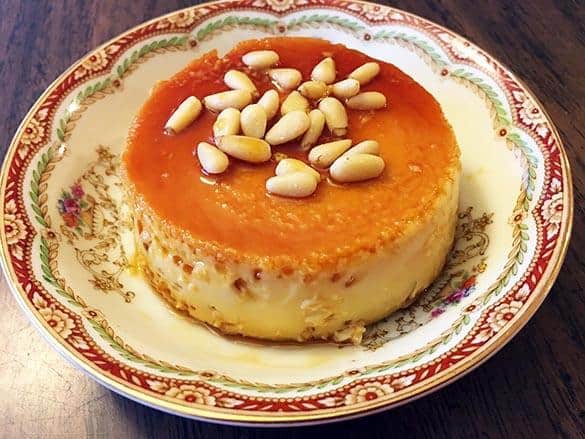 Piñon Flan. Photo by Liddie Martinez
Piñon Flan. Photo by Liddie Martinez
 By LIDDIE MARTINEZ
By LIDDIE MARTINEZThere must be at least a small Roman gene in my genetic makeup because, like the Romans, I am crazy about chickens! Chickens were domesticated by the ancient Romans and kept for laying eggs. And, as any cook with a flock of chickens will tell you, you get very inventive on uses for the little gems that tend to be highly prolific and in short form will take over your kitchen. I love their versatility and the fact that they are low in calories and high in protein. While the eggs themselves may not have ranked very high in the culinary selections of the Romans in their time, they did experiment with them and quickly found a use for them as binders and thickening agents. This innovative experimentation led the ancient Romans to develop the first known recipe for flan and for that; I will claim them as my people.
In those days, flan was a savory dish often paired with eel but eventually, they discovered that flan was an excellent vehicle for other flavorings. Most common in those times were the savory flans made with fowl or game seasoned with saffron, cinnamon and nutmeg. Eventually, they added honey to the mix and the sweetness combined so well with the custard that that version stuck. But it was the Spanish that poured caramel over flan and brought it to New Mexico in the 1500s! And, this is the version we all fell in love with!
When my sister and I were young teens, we would pool our money and go a local restaurant to make the rare purchase – one flan to share. Mom discovered this and, being a thrifty homemaker, quickly taught us how easy and inexpensive it was to make at home reminding us that we always had all the ingredients needed to whip up a batch anytime we wanted.
I have always had a flock of chickens to tend and using the freshest eggs available is a must in making this delicate custard. There are three key elements to a perfect flan: use a water bath, know your oven and allow for ample time in the fridge to set. If you can master these three things, you will find success.
What do I mean by “know your oven”? One major mistake often made in baking delicate desserts is not having faith in your oven. If you can’t trust your oven, you will be compelled to open the oven door to check on your dish. Every time you open the oven door, the heat rushes out, the cool air rushes in and you have increased the cooking time which will affect the success of the dish. Open that oven door a few too many times and your flan will turn to rubber. You may have to make the dish two or three times before you have the perfect timing for your oven but it is worth the effort and don’t forget to jot down notes in your cookbook or on your recipe. It is not a dish you make often enough to remember specific timing or settings.
A perfectly baked flan is a thing of beauty and easy to make once you know how to do it. When it is firm but still jiggles slightly in the center, it is done. Quickly take it out of the oven and out of the water bath and cool completely before refrigerating. Don’t leave it sitting in the water bath or it will continue to cook on your counter. Also, try not to disturb the custard in the pan while is it cooling and setting. You should not attempt to invert onto your serving dish until it has been in the refrigerator for at least 2-3 hours but overnight is better. One more thing, caramelized sugar is very dangerous so please be sure no children or pets are underfoot in the kitchen while preparing this dish.
For my version I added piñon nuts, but you may omit them or substitute with almonds.
3 Large Eggs plus 2 egg yolks
2 Cups sugar
½ Cup piñon nuts
1 Tbsp. Grand Marnier
1 Can evaporated milk
1 Can sweetened condensed milk
1 ½ tsp. vanilla
1 kettle boil water
Preheat oven to 350°. Place a folded tea towel at the bottom of a 9X13 casserole dish (6 ramekins will fit in the dish without touching each other). Place about one Tablespoon of piñon nuts at the bottom of each ramekin and set aside. Put water in kettle and bring to a boil.
Meanwhile, in a cast iron skillet or heavy sauce pan melt sugar over medium heat until liquefied and golden brown. Add Grand Marnier, stir well and pour evenly into each ramekin over nuts swirling slightly to cover bottom and edges. Place on tea towel in casserole and set aside.
In a large mixing bowl with a pour spout, beat (not whisk) eggs and yolks with milks and vanilla until smooth but stop before air bubbles have formed. Pour evenly into the ramekins and place casserole dish in the center of the over. Carefully pour boiling water into the casserole coming halfway up the dishes. Bake for 55 minutes or until custard is firm but center still wiggles. Cool completely on counter then refrigerate for 2-3 hours or overnight. Run a knife around the edge before turning out onto serving dish.
Make 6 servings.

